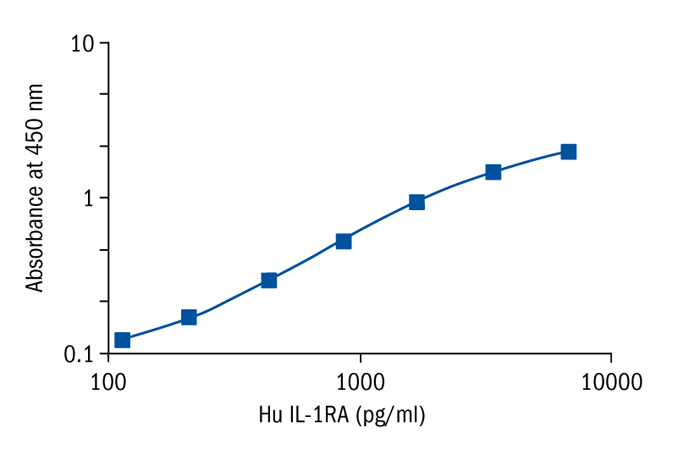Type
Sandwich ELISA, Biotin-labelled antibody
Description
The human IL-1RA ELISA is an enzyme-linked immunosorbent assay for the quantitative detection of human IL-1RA. The human IL-1RA ELISA is for research use only. Not for diagnostic or therapeutic procedures.
Applications
Serum, Plasma-EDTA, Plasma-Heparin, Plasma-Citrate, Cell culture supernatant
Sample Requirements
50 ul/well
Shipping
On blue ice packs. Upon receipt, store the product at the temperature recommended below.
Storage/Expiration
Store the complete kit at 2–8°C. Under these conditions, the kit is stable until the expiration date (see label on the box).
Calibration Curve
Calibration Range
109–7000 pg/ml
Limit of Detection
30 pg/ml
Intra-assay (Within-Run)
CV = 7.2%
Inter-assay (Run-to-Run)
CV = 7.4%
Specificity
The assay detects both natural and recombinant human IL-1RA. The cross reactivity and interference of circulating factors of the immune system was evaluated by spiking these proteins at physiologically relevant concentrations into a human IL-1RA positive sample. There was no cross reactivity or interference detected.
Features
- RUO
- calibration range 109-7000 pg/ml
- limit of detection 30 pg/ml
- intra-assay CV = 7.2%
- inter-assay CV = 7.4%
Research topic
Cytokines and chemokines and related molecules
Summary
Interleukin 1 receptor antagonist (IL-1RA) is a protein that appears to be related to the IL-1 family based on its similarities in amino acid sequence to both IL-1 beta and IL-1 alpha; similarities in gene structure; and collective gene localization. The human gene contains four exons and maps to chromosome 2q13-14. One exon in the vicinity of the two genes, encoding for the two molecular forms of IL-1.
IL-1 induces the release of prostaglandins, nitric oxide and the synthesis of chemokines that promote cells of the immune system to the site of infection. IL-1RA binds to the IL-1 receptor and blocks IL-1 action through competitive inhibition. The binding of IL-1RA does not initiate such events because IL-1RA does not induce a signal on its own. The secretion of IL-1RA is apparently mediated by a classical signal sequence present at the N terminus of the protein that is encoded in the first exon of the IL-1RA gene. Neither IL-1 alpha nor IL-1 beta possess such a sequence. The lack of homology between IL-1RA and IL-1 alpha or IL-1 beta near the N terminus may provide an explanation for the biosynthetic and functional differences between IL-1RA and the two IL-1 proteins.
The production of IL-1RA is stimulated by many substances including adherent IgG, other cytokines, and bacterial or viral components. Triggering IL-1 production through cytokines like IL- 13, IL-6, IL-4, IFN-γ, GM-CSF and TGF-β apparently triggers IL-1RA synthesis through elevated levels of IL-1. A number of cell types express IL-1RA, including monocytes, macrophages, neutrophils, Sertoli cells, hepatocytes, adipocytes, synovial fibroblasts, mast cells, pancreatic cells and intestinal epithelial cells. IL-1RA is an important natural anti-inflammatory protein that when missing or just available in inadequate amounts plays a key role in several pathological conditions such as rheumatoid arthritis, colitis, osteomyelitis, periostitis and pustulosis. A polymorphism of the IL-1RA gene is reported to be associated with increased risk of osteoporotic fractures and gastric cancer.
In healthy tissue sufficient interleukin-1-receptor antagonist is produced to hold interleukin-1-mediated inflammation at bay. In cases of uncontrolled inflammation, there is an insufficient amount of interleukin-1-receptor antagonist to regulate the activity of interleukin-1.
Find documents for the lot
Example Instructions for Use (RUO)
Example Instructions for Use (RUO)
Safety Information (RUO)
MSDS (RUO)

